Chile and Peru are neighbours, sharing the Pacific coast of South America and the Andes mountains to the east. They also share the Spanish influence and a colourful history of immigration – resulting in the infusion into their cuisine of influences from all over the world. Maybe that’s why their cuisines are as distinct from one another as their wildlife: In Peru, they adore Alpacas. In Chile, they love Llamas.
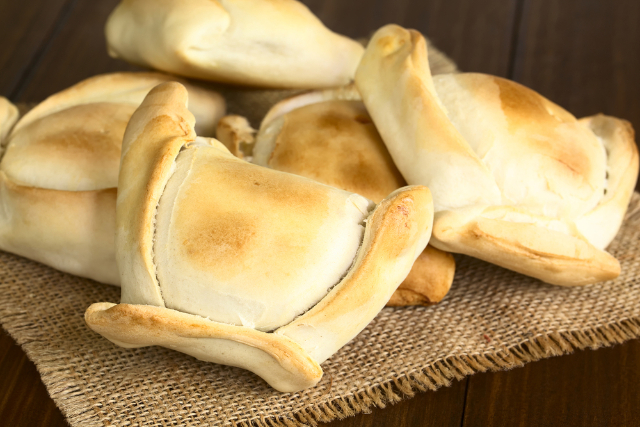 Chilean Empanadas: The King of Chilean street foods!
Chilean Empanadas: The King of Chilean street foods!
Other crucial differences between Chile and Peru include its latitude and relationship to the mountains.
According to Wikipedia: “From north to south, Chile extends 4,270 km (2,653 mi), and yet it only averages 177 km (110 mi) east to west. Chile reaches from the middle of South America’s west coast straight down to the southern tip of the continent.” And, rather than spilling over the mountains into the lush Amazon watershed as Peru does, Chile sticks to the western side of the Andes. Where Peru lies mainly in the subtropic and tropic climate zones (like Central america and Mexico), Chile enjoys a variety of climates, from the sub-tropics in the north to the temperate zone in the south. In this sense, it’s not unlike the U.S. – just turned upside down.
Copper mining is one of the biggest resource industries in Chile, while agriculture is largely characterized by cattle and llama ranching, and the growing of fine wines. But Chileans also love their pork, as is demonstrated by the abundance of pork dishes on their national menu!
On our menu today:
Pastel de Choclo: Sounds like simple peasant food, but this is the national dish of Chile! Freshly picked corn kernels are blended with garlic, onion, hard-boiled eggs, olives, and minced meat (usually chicken). Then the whole thing is baked in an earthenware bowl. This casserole is often served with veggie Tamales.
Empanadas: Chilean Empanadas are very similar to those of other countries that have, over time, felt the Spanish influence. They can be filled with anything, but the hands-down favourite (and the king of Chilean street food!) is the Pino. Pino is a filling consisting of meat, onions, hard-boiled eggs, black olives, and raisins. They’re unique in that they’re square in shape, and their pastry pockets are crimped on three sides in what resembled a goofy smile. Chilean Empanadas may be baked or deep fried.
Essential seafoods…
Chilean Sea Bass: Woe betide the food writer who neglects to mention the country’s most famous and beloved export: Sea Bass.
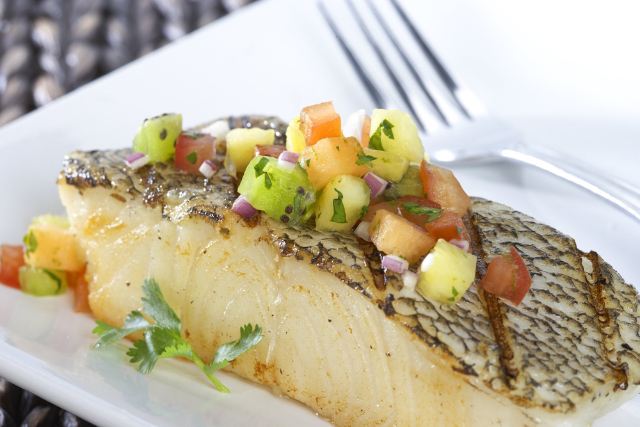
It’s a delectable whitefish, caught all along the Chilean coast, which can be prepared and served in just about any way you can imagine. It is often simply baked and topped with Chilean style Pico de Gallo…
Machas a la Parmesana: Machas (clams) are marinated in white wine, cream and butter, topped with Parmesan cheese, and sizzled under the broiler. This popular dish was introduced by Italian immigrants who arrived in the 1950s and it’s since swept the country!
Chupe: A seafood ‘soup’ (or, if you like, stew) usually based on shrimp or fish, supported by veggies and potatoes. Different cooks have their own ‘secret’ herb and spic blends. There’s no set regimen. The traditional recipe calls for crayfish, but these days shrimp are much easier to obtain. Milk is added before serving to create a silky, texture. Serve with warm bread fo0r dipping!
Where’s the Beef (and Pork, and Chicken)?
Pernil: This is classic Chilean roasted pork. The shoulder or leg, with the skin on, is usually marinated overnight in Chilean Sofrito (a blend of herbs and aromatic veggies – imported by the Italians), salt, pepper and oregano. It’s slow roasted until the skin is bronzed and crispy, and the meat falls off the bone and served with a mixture of rice and peas called arroz con gandules. This is then unofficial national Christmas Supper dish.
Arrollado de Huaso: This rolled pork roast has a lot in common with the classic Italian Porchetta. The pork roll (tenderloin wrapped in belly fat) is gets an outer wrap of pig skin, and is topped with bacon, chilis and spices. The whole ting is broiled to juicy tenderness and served with a side of seasonal veggies and avocado salsa.
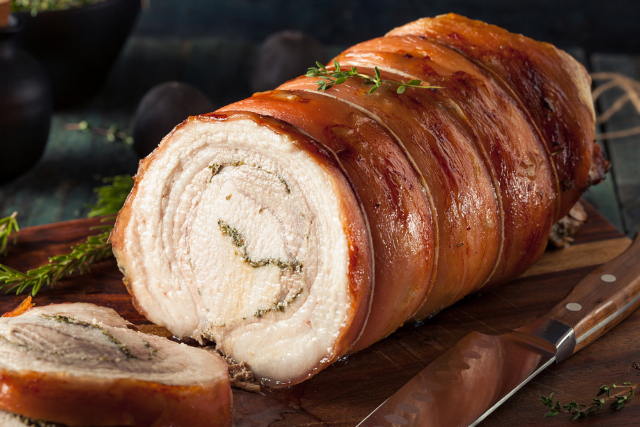
Have you noted the predisposition of Chileans to wrap their pork dishes in pig skin? This keeps the juices in and preserves the flavour…
Plateada: If you like Pot Roast, you’ll love Plateada, Chile’s national Roast Beef. It’s made from the rib cap (found above the rib eye) roasted with garlic, salt, fresh ground pepper, olive oil, and onions. The meat is always marinated to ensure that it turns out fall-apart tender and juicy. Every Chilean cook has their own marinade recipe.
Cazuela: This soup/stew is a hearty bowlful of chunky meat, big pieces of squash and potatoes, and corn on the cob. The solids are simmered in a cooking pot called a Cazuela (perhaps a distant cousin of the North African Tajine) in a broth containing peppers, quinoa, and chili.
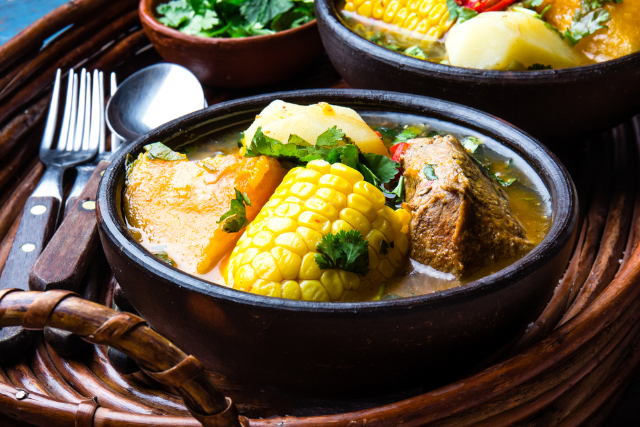
The classic meat featured in a Caszuela is Chicken, but other meats are often used, depending on what’s avialable.
Charquicán: Simply beef stew, though Llama is sometimes used. Found all over southern Chile. According to one reference, it’s ‘slow cooked and loaded with local Chilean squash, peas, corn, and potatoes’. It’s sometimes eaten for breakfast topped with a fried egg. You’ll find echoes of Charquicán in the classic beef stews of most south American countries.
Essential sides…
Pebre: This is the Chilean national Salsa (see photo, top of page). It’s a compound of finely chopped tomatoes, onions, chili, chives, garlic, coriander, oil and vinegar. It’s relish-like consistence makes it useful for garnishing and topping almost any savoury dish. Sources say it’s a fixture on all Chilean dinner tables…
Pan amasado: The classic Chilean every-day bread is a soft, light product with the silky character of a European ‘White Dinner Rolls’. In Mexican restaurants, you’ll often get an automatic appetizer of corn chips and salsa. In Chile, it’s Pan amasado and Pembre!
Sopapillas: Like their near-cousins found in other central and South American countries, Chilean Sopapillas are deep-fried desserts loved by kids and adults alike for snacks. They come in round, triangular or square shapes usually dusted with powdered sugar or topped with honey. A popular street food, along with one or more of the sandwiches below!
Chilean specialties with an imported influences…
Besides the Arollada and Machas a la Parmesana, there are many other dishes that are c0onsidered typically Chilean, but owe their unique characters to imported influences….
The Completo: The ‘classic’ Chilean Hot Dog! I use the single-quotes around classic to denote their imported influence. They are large sausages (larger than North American and European frankfurters), served in what we would all recognise as a Hot Dog Bun, and topped with mayo, tomatoes, onions, pickles, and sauerkraut – or your choice of the above.

The ‘Italiano’ version (pictured above)features mayo, tomatoes, and avocado. A favourite Chilean street food!
Chorillana: Definitely imported from elsewhere, this favourite ‘sharing’ dish consists (as one source puts it) of ‘a huge pile of french fries with delicious toppings’. It’s often topped with sautéed onions, shredded beef, sausage, and fried (or sometimes scrambled) eggs. (Many other toppings may also appear…) Notice the resemblance to ‘loaded’ Nachos? Somehow, this dish has found its way into most corners of the eastern world! More a bar food than a street food, it’s found on both environments. Usually considered a ‘snack’, it may be considered a meal; if hogged by a single diner.
Churrasco: The classic Chilean Steak Sandwich, Churrasco is a street food extraordinaire. At first sight, you’ll see a superficial resemblance to the Philly Cheese Steak and the Roast Beef Po-Boy. But the Chilean version diverges from all others at that point.
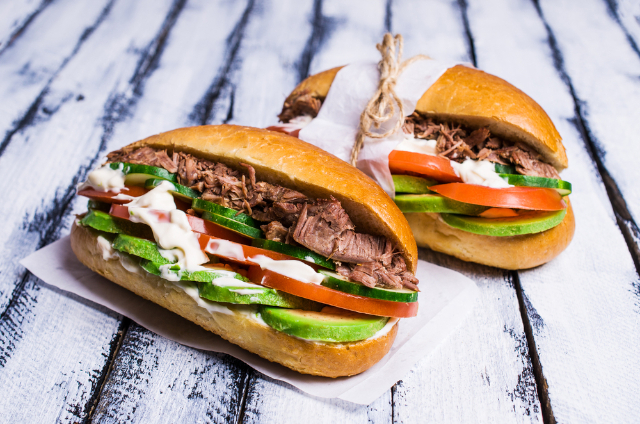
You start with a layer of thinly-sliced grilled beef steak on a specially made Hoagie-shaped Pan amasado bun, and what you top it with from there determines which variant of this universal dish you’re ordering. Classic Currasco features caramelized onions, a fried egg and a side of fries. Churrasco Italiano is topped with mayo, tomato, and avocado – toppings also found on other Chilean dishes touched by Italian influence. The Italiano, we’re advised, is the most popular of the Churrascos.
And there you have it!
Our mouthwatering tour of Chilean cooking is, alas, over. But I know you’ll come back again and again to look up these amazing dishes and Google their recipes so you can try them yourself! How easy would it be to turn a plain Hot Dog into a reasonable facsimile of a Completo? How hard would it be to create your own version of a Chorillana? Nobody needs to know how easy it was to make that amazing Plateada roast. Or roll up an Arrollado de Huaso for a welcome change from your next usual holiday roast…
You may never get to visit Chile, but making and enjoying some of their national classics may well be the next best thing!
~ Maggie J.

